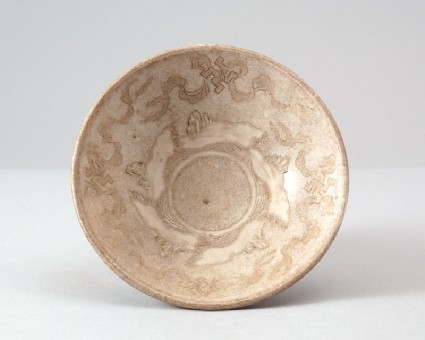Browse: 144 objects
White ware bowl with rocks emerging from waves
- loan
-
Details
- Associated place
-
Asia › China › Hebei province (place of creation)
- Date
-
9th - 10th century AD (AD 801 - 1000)
Tang Dynasty (AD 618 - 907)
- Material and technique
- stoneware, thrown, with painted decoration under a white glaze; incised decoration cut through a white glaze; unglazed base; glazed rim
- Dimensions
-
4.1 cm (height)
14 cm (diameter)
- Material index
- Technique index
- Object type index
- No. of items
- 1
- Credit line
- Lent by the Sir Alan Barlow Collection Trust.
- Accession no.
- LI1301.322
-
Further reading
University of Sussex, and Arts and Humanities Research Council, The Barlow Collection, supervised by Regina Krahl, Maurice Howard, and Aiden Leeves (Sussex: University of Sussex, 2006), no. C320
Glossary (2)
glaze, stoneware
-
glaze
Vitreous coating applied to the surface of a ceramic to make it impermeable or for decorative effect.
-
stoneware
Ceramic material made of clay which is fired to a temperature of c.1200-1300⁰c and is often buff or grey in colour.
Location
-
- currently in research collection
Objects are sometimes moved to a different location. Our object location data is usually updated on a monthly basis. Contact the Jameel Study Centre if you are planning to visit the museum to see a particular object on display, or would like to arrange an appointment to see an object in our reserve collections.
Publications online
-

The Barlow Collection
Bowls with a low disc-shaped foot, reminiscent in form of an archaic jade disc (bi), both with a white glaze, made in north China, and with a green glaze, made in the south, were among the first high-fired stonewares to be exported to the Middle East. Since excavations in Samarra in the early 20th century for the first time brought to light bowls with this distinctive feature, the whole type has become known as Samarra-type bowls (or the foot as a Samarra-type foot). The design on the present piece has been carved into the glaze in modern times.
The conical bowl rests on a very shallow disc-shaped foot and has a thick folded-over rim flange. The off-white body is covered with an opaque white glaze which leaves the foot, base and patches around it free. The glaze has a degraded, soiled surface into which a design of four swastica motifs tied with ribbons and a band of rocks emerging from waves has been cut after firing. -

The Barlow Collection
Bowls with a low disc-shaped foot, reminiscent in form of an archaic jade disc (bi), both with a white glaze, made in north China, and with a green glaze, made in the south, were among the first high-fired stonewares to be exported to the Middle East. Since excavations in Samarra in the early 20th century for the first time brought to light bowls with this distinctive feature, the whole type has become known as Samarra-type bowls (or the foot as a Samarra-type foot). The design on the present piece has been carved into the glaze in modern times.
The conical bowl rests on a very shallow disc-shaped foot and has a thick folded-over rim flange. The off-white body is covered with an opaque white glaze which leaves the foot, base and patches around it free. The glaze has a degraded, soiled surface into which a design of four swastica motifs tied with ribbons and a band of rocks emerging from waves has been cut after firing.
© 2013 University of Oxford - Ashmolean Museum



